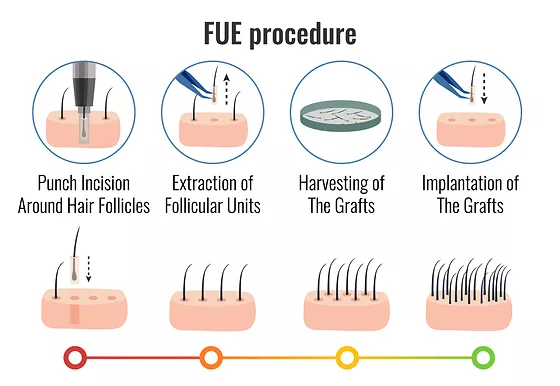
What is FUE Hair Transplant?
The FUE technique is the latest in hair transplantation techniques. The hair grafts are harvested from the donor area of the scalp using a punching device, around 0.75mm to 1mm in size. The grafts are then placed into microscopic incisions in the receiving area. The surgeon pays close attention to placement and the grafts are placed in the scalp in the same pattern as the natural hair. The final result is a stunning result. The surgery will leave tiny scars, which are barely noticeable.
Before the procedure, the physician will discuss the process with the patient. He or she will discuss your expectations for the procedure and answer any questions you may have. A small scab will form over the small incisions, but will eventually fade away. As with the FUT procedure, recovery is fast. After the surgery, you may experience swelling for about three days. You will need to use gentle shampoos for a couple of weeks and take a few days off work to speed up the healing process.
The FUE procedure involves shaving the back of the scalp and harvesting hair follicles. Once harvested, these grafts are labeled and grouped based on the number of hair follicles in each unit. The donor area is shaved to ensure that the grafts are not mixed with the existing hair. As with the FUT procedure, the surgeon will prepare the grafts by making tiny incisions in the areas of restoration. He will then place each graft in a hole or slit. Other team members will assist with this task.
The procedure is not painful and the results are natural and permanent. However, some patients experience drainage and swelling, and they should avoid direct sunlight for two to three weeks after the surgery. Afterwards, they should sleep with their head elevated and avoid sun exposure for about two weeks. After the surgery, the donor site is likely to ooze some blood. You should follow the doctor’s instructions for medication and rest. It is important to stop all medications at least one week before the surgery, as some of them can increase the bleeding.
Although the FUE procedure does not leave a linear scar in the donor region, it does leave thousands of “dot” scars. The procedure also requires some time to recover. After the procedure, you should rest for at least one day, and expect to be slightly sore. The donor area will be very irritated for a few days, but it is only minor. If you are planning on having a hair transplant, make sure you choose an experienced surgeon with specialized training in FUE.
FUE involves less discomfort than the other procedures. You will only need a few days off of work after your procedure, and you should avoid wearing hairpieces or other items on your head during this period. Your overall health will affect the outcome of your procedure. This is because your physician will take care of everything for you, and your hair will not be damaged in any way. In addition to this, the FUE method can also be done on thin skin.




